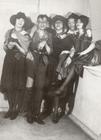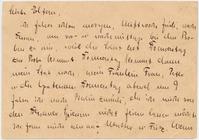This collection is also available in Archives & Manuscripts
View In Archives »
Collection Data
- Description
- Ronald Sanders was an author, teacher, and lecturer on Jewish history and related topics. His papers include correspondence with family and friends, as well as other authors of note such as Yehuda Amichai, Sir Isaiah Berlin, Peter Gay, Shlomo Katz, Bernard Malamud, Alma and Isaac Bashevis Singer, and Elie Wiesel; drafts, research notes and audiotaped interviews for his books and articles; class and lecture notes; several unpublished works; his college papers; and some personal materials from his travels.
- Names
- Sanders, Ronald, 1932-1991 (Creator)
- Amichai, Yehuda (Correspondent)
- Berlin, Isaiah, 1909-1997 (Correspondent)
- Katz, Shlomo (Correspondent)
- Malamud, Bernard (Correspondent)
- Singer, Isaac Bashevis, 1904-1991 (Correspondent)
- Wiesel, Elie, 1928-2016 (Contributor)
- Dates / Origin
- Date Created: 1951 - 1994
- Library locations
- Manuscripts and Archives Division
- Shelf locator: MssCol 3617
- Topics
- America -- Race relations
- Cahan, Abraham, 1860-1951
- Immigrants -- New York (State) -- New York
- Jewish college students
- Jewish diaspora
- Jews -- Lower East Side (New York, N.Y.)
- Jews -- New York (State) -- New York -- Lower East Side
- Jews -- New York (State) -- New York -- Social life and customs
- Press, Socialist
- Socialism
- Weill, Kurt, 1900-1950
- Zionism -- Great Britain
- Zionism -- History
- Authors, American
- Balfour Declaration
- Forṿerṭs
- Midstream (New York, N.Y.)
- Brooklyn (New York, N.Y.) -- History
- Israel -- History
- Masada Site (Israel)
- Genres
- Scrapbooks
- sound recordings
- Notes
- Biographical/historical: Ronald Sanders was born on July 7, 1932 in Union City, New Jersey. His father was English-born Tin Pan Alley musician George H. Sanders, who penned the nursery rhyme, I'm a Little Teapot. His mother, Rose Rachlin, was the daughter of Russian-Jewish immigrants. They met and married in New York in 1925. They had two children, Marilyn and Ronald.
After Ronald's birth the family moved to the Flatbush section of Brooklyn, N.Y. He attended public schools between 1938 and 1950 and then continued on to Kenyon College in Gambier, Ohio, in 1950. He was awarded the 1950 George F. Baker Scholarship. Sanders majored in English literature and studied with eminent poet and critic, John Crowe Ransom. He served as the editor of the school's literary magazine. In 1953 he was inducted into Phi Beta Kappa.
Later that year Sanders entered the U.S. Army. He completed his college degree in 1954 at the end of the first of his two years of military service, where he served as a corporal. Free time was spent discussing politics and culture with others in the barracks, publishing the 28th Infantry newspaper, and working with a local theatre company. During boot camp, soldiers were required to fill out various forms, including one for their dog tags. One question asked for their preference of religious affiliation. Though he was raised in a home where neither Anglican nor Jewish parental faith traditions were practiced, the only relatives Sanders knew were his mother's warm Jewish family. He chose to place a Jewish identifier on his dog tag. This decision proved to be significant life choice.
Returning to New York in 1955 following his Army discharge, Sanders considered law and medicine as possible careers paths. But Sanders wanted to write and study history. Reasoning that a career in academia would allow him to do both, he pursued that path by studying American history at Columbia University. His subject interests, socialism and Jewish history, became intertwined in his Master's thesis, Abraham Cahan and The Jewish Daily Forward. He completed his Master of Arts in 1957 and continued with doctoral studies in early modern European history at Columbia, while teaching history at Queens College in the evening. French socialist Jean Jaurès became the focus for Sanders' dissertation studies. In 1960 he won a Fulbright Fellowship to live to Paris and research his subject. During this year abroad Sanders took advantage of a group excursion to the Soviet Union, and concluded his year away with two months in Israel. These experiences would also have significant influences on the course of his life.
Sanders resumed his position at Queens College upon returning home, but his travels had left a strong impression on him, particularly an experience in the Soviet Union. While in Moscow he visited an old synagogue where he began chatting, in Yiddish, with an elderly man. They discussed current life in the city and times past. Sometime later Sanders, reflecting back on this encounter, wrote that he felt he had seen the Jewish future while visiting Israel, but had connected with a living Jewish past in Moscow.
Prior to his travels abroad Sanders had established himself as an writer by publishing book reviews in professional journals. In 1962 the monthly Jewish Review, Midstream,chose him to write the main article in their issue celebrating the 100th aniversary of the publication of Moses Hess' Rome and Jerusalem,which was the call for the establishment of a Jewish state. The success of that article led to another on the American Yiddish press, a familiar subject thanks to his Master's thesis.
Sanders continued to teach, but academic advancement was taking a back seat to non-academic writing projects. In 1963 he took a year's leave to live in Israel, study Hebrew and work on the archeological dig at Masada, hoping to turn his experiences there into a book. He returned again to Queens College at the end of this leave, but it became apparent to the school administration that he was not going to complete his doctoral studies and they did not offer him a contract for the new academic year
His literary abilities established, Sanders was offered and accepted a position as an Assistant Editor at Midstream. He worked there steadily until 1975, the last three years as Editor-in-Chief. His position at Midstream did not, however, curtail other writing projects. In 1966 Sanders published Israel: The View from Masada,the memoir of his experiences in Israel. His next volume, Downtown Jews: Portrait of an Immigrant Generation, was published in 1969. By the time he left Midstream to write full-time, Sanders had published over 22 principal articles and numerous reviews, editorials, and occasional pieces for that magazine and several articles for Commentary.He had contributed to three volumes on Jewish history and the Middle East, co-edited an anthology, and published three of his own full-length works. He had also written dozens of short articles and book reviews that were published in periodicals such as The New York Times Book Review,The New Republic,and The Nation,among others. In 1970 he was awarded the B'nai B'rith Book Award .
As a freelance writer Sanders published five additional major works on Jewish subjects, including The High Walls of Jerusalem: A History of the Balfour Declaration and the Birth of the British Mandate for Palestine (1984), considered by many to be the definitive work on that subject. He continued to write and publish short pieces and became an independent lecturer for convocations or college classes and Jewish community centers. He was a visiting lecturer at Haverford College in the 1984 - 1985 academic year and taught a class at the Bennington Writers Workshop in Vermont in the summer of 1985.
In 1989 Sanders was invited to apply for the B.G. Rudolph Chair in Jewish Studies at Syracuse University. After several rounds of lectures and presentations, Sanders was offered the Chairmanship for the 1988-89 academic year. He delivered the annual B.G. Rudolph Chair in Jewish Studies Lecture on October 29, 1988 on the subject of The Americanization of Isaac Bashevis Singer. He intended this lecture to be the basis for his next full-length work, but it was not to be. Though he accepted the Chairmanship, he had to withdraw his acceptance soon after due to failing health. Sanders had been diagnosed with cancer. Though he continued writing, applied for and won a 1991-92 National Endowment for the Humanities grant to conduct research for the Singer book, he did not live to use it, succumbing to bone and liver cancer on January 11, 1991.
Sanders married Beverly Gingold, a teacher and later an editor of American Crafts magazine, on March 19, 1967. They made their home in New York City. They have no children.
- Content: The papers of Ronald Sanders (1951-1994; 22.5 lin. ft.) include correspondence; manuscript and typescript drafts of books, articles, and stories; notes and research materials for the same; newspaper and magazine clippings; memorabilia; artwork; sheet music; postcards; photographic prints and negatives; scrapbooks; and audiocassettes. Sanders' topics of interest were mainly historical and political. Socialism captured his attention as a young man, and was his focus throughout his formal education, including his doctoral dissertation subject. Later on, history, particularly Jewish history and culture, became his central focus.
The Sanders Papers are a good example of a collection which documents the entire scope of one author's body of work. While the bulk of the materials are drafts and research notes for Sanders' mature, full length works (Boxes 6-40), there is significant documentation of stories and essays from his younger years. The collection includes many of his undergraduate class papers from English, Poetry, and History classes, as well as Philosophy and Political Science. Versions of the essay which he developed into his Masters' thesis, and the thesis itself, are also included (Box 41, folders 1 and 24 and Box 47, folders 3, 4, and 12). The collection has many of the book reviews and miscellaneous pieces he wrote throughout the years (Boxes 41-43), as well as drafts of many of the lectures that capped his career (Box 49 and 50).
His work at Midstream is well documented with examples of articles he wrote for that publication (Box 5). Of note in the series is correspondence between Sanders and Editor Shlomo Katz,including the dispute that led to Sanders' departure from the magazine. (Additional correspondence with Katz is found in the "Individual Correspondence" series, Box 1.) Several unpublished works, some incomplete, are also in the collection, including several chapters and notes from a murder mystery from his mature years (Boxes 45-46), one of just a few pieces of fiction by Sanders.
For researchers curious about Sanders' personal life, the collection documents his non-literary pursuits as far back as high school. Series V, "Personal and Other Items" (Boxes 51-53) documents Sanders early interest in drawing and painting (Box 51, folder 4, Box 52, folder 8, and Box 53, 3 paintings). This series also includes materials and memorabilia from his year in France and his trips to the Soviet Union and Israel (Box 51, folder 11-12 and Box 52, folder 4). Letters from his parents (Box 2) shed light on his youth. The materials from individual correspondents of note (Box 1) include letters from long-term friends Bill Goldhurst and Uriel Tal as well as other literary friends and contacts.
Sanders' memoir, Reflections on a Teapot, (Box 8-11) provides a first hand account of his childhood in Brooklyn and particularly the time he spent in the Army. There is very little else about his Army experience in this collection, outside of these chapters, a play program, and a review of theatrical productions in which Sanders had a part during his time in the Army (Box 51, folder 5 and Box 52, folder 10.)
- Physical Description
- Extent: 22.5 linear feet (54 containers)
- Type of Resource
- Text
- Still image
- Sound recording
- Identifiers
- NYPL catalog ID (B-number): b15590977
- MSS Unit ID: 3617
- Universal Unique Identifier (UUID): 47c6fdb0-fd32-0135-ee32-59102e4df940

